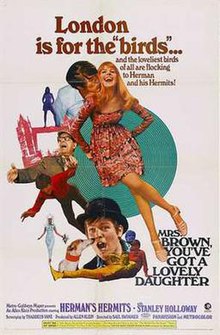Mrs. Brown, You've Got a Lovely Daughter (film)
| Mrs. Brown, You've Got a Lovely Daughter | |
|---|---|
 | |
| Directed by | Saul Swimmer |
| Written by | Thaddeus Vane |
| Produced by | Allen Klein |
| Starring | |
| Cinematography | Jack Hildyard |
| Edited by | Tristam Cones |
| Music by | |
Production company | Ivorygate Films |
| Distributed by | Metro-Goldwyn-Mayer |
Release date |
|
Running time | 95 minutes |
| Country | United Kingdom |
| Language | English |
Mrs. Brown, You've Got a Lovely Daughter is a 1968 British musical comedy film directed by Saul Swimmer and starring Peter Noone.[1][2] The film showcases the British rock band Herman's Hermits, and is their second and final feature film, following Hold On! in 1966. The group sings nine songs including the title track and the romantic hit song "There's a Kind of Hush".[3]
Plot
[edit]Herman Tulley inherits a prize greyhound called Mrs. Brown and aims to race the dog and win the derby in London. Herman and his group, The Hermits, play gigs to raise money for the race entry fees. After Mrs. Brown wins the preliminaries in Manchester, The Hermits travel to London for the big race. However, they must again raise money to enter their greyhound, so they make arrangements for more concerts and also take up temporary employment at G.G. Brown's fruit market. During this time, Herman falls for Judy, an aspiring young model who is the Browns' daughter, but Herman's neighborhood friend Tulip has her sights set on him. Mrs. Brown wins the London race, but is later lost by Herman after he ties her to a baggage cart at a busy railway station. She eventually is found by a street entertainer and returned and gives birth to a "daughter." Judy does modeling in Rome. Herman winds up moving on with the hint of a possible relationship with Tulip.
Cast
[edit]- Peter Noone as Herman Tulley
- Keith Hopwood as Keith
- Derek Leckenby as Derek
- Karl Green as Karl
- Barry Whitwam as Barry
- Stanley Holloway as G.G. Brown
- Mona Washbourne as Mrs. Brown
- Marjorie Rhodes as grandma Gloria
- Lance Percival as Percy the tramp
- Sheila White as Tulip
- Sarah Caldwell as Judy Brown
- Hugh Futcher as Swothard
- Drewe Henley as Clive
- Avis Bunnage as Tulip's mother
- John Sharp as Oakshot
- Tom Kempinski as Hobart
- Nat Jackley as pub singer
- Billy Milton as landlord
- Dermot Kelly as con man
- Joan Hickson as landlady
- Lynda Baron as Miss Fisher
- Annette Crosbie as maid
- Pamela Cundell as woman on embankment
- Jessie Robins as woman in pub
Production
[edit]It was shot at Shepperton Studios and on location around London and Manchester, including King's Cross Station, Covent Garden, St Katharine Docks and the Great West Road. The greyhound racing scenes were shot at the Catford Stadium and White City Stadium. The film's sets were designed by the art director George Provis.
Critical reception
[edit]The Monthly Film Bulletin wrote: "Another mongrel child born out of English neo-realism (clean linen waving like flags from the washing lines of picturesque northern slums) and the myth of a trendy London in which all the younger people are connected with a colour supplement and dressed in last year's gear. Although Herman and his Hermits rush eagerly around England's principal tourist attractions and everyone involved displays an indomitable (and presumably exportable) cheeriness, the message that emerges is a sadly negative one: the world is for the young, or as the heroine puts it, "One only has a few super years". It is characteristic of the film's ephemeral and pathetically swinging world that when Judy tells Herman that she's going to Rome (via St. Pancras, incidentally) for six weeks, he should automatically assume "It's all over, then"."[4]
In DVD Talk, Bill Gibron wrote "It's almost impossible to embrace this movie as well made and amusing. It is an entertaining antique, but that's about it."[5]
In The Spinning Image, Graeme Clark described the film as "something of an improvement on the Hermits' previous movie, Hold On!...The songs are better...what you're left with is an artefact that was not intended to last down the ages, but has anyway."[6]
References
[edit]- ^ "Mrs. Brown, You've Got a Lovely Daughter". British Film Institute Collections Search. Retrieved 15 August 2024.
- ^ "Mrs. Brown You've Got a Lovely Daughter (1968) - BFI". BFI. Archived from the original on 4 August 2012.
- ^ "Mrs. Brown, You've Got a Lovely Daughter (1968) - Trailers, Reviews, Synopsis, Showtimes and Cast - AllMovie". AllMovie.
- ^ "Mrs. Brown, You've Got a Lovely Daughter". The Monthly Film Bulletin. 35 (408): 182. 1 January 1968 – via ProQuest.
- ^ "Mrs. Brown, You've Got a Lovely Daughter". DVD Talk.
- ^ "Mrs. Brown You've Got a Lovely Daughter Review (1968)". www.thespinningimage.co.uk.
External links
[edit]- 1968 films
- 1968 musical comedy films
- British musical comedy films
- Jukebox musical films
- Metro-Goldwyn-Mayer films
- Films scored by Ron Goodwin
- Films set in London
- Films shot in London
- Films set in Manchester
- 1960s sports films
- British sports comedy films
- Films and television featuring Greyhound racing
- Films shot at Shepperton Studios
- Films shot in Greater Manchester
- Greyhound racing films
- 1960s English-language films
- 1960s British films
- English-language musical comedy films
- English-language sports films
